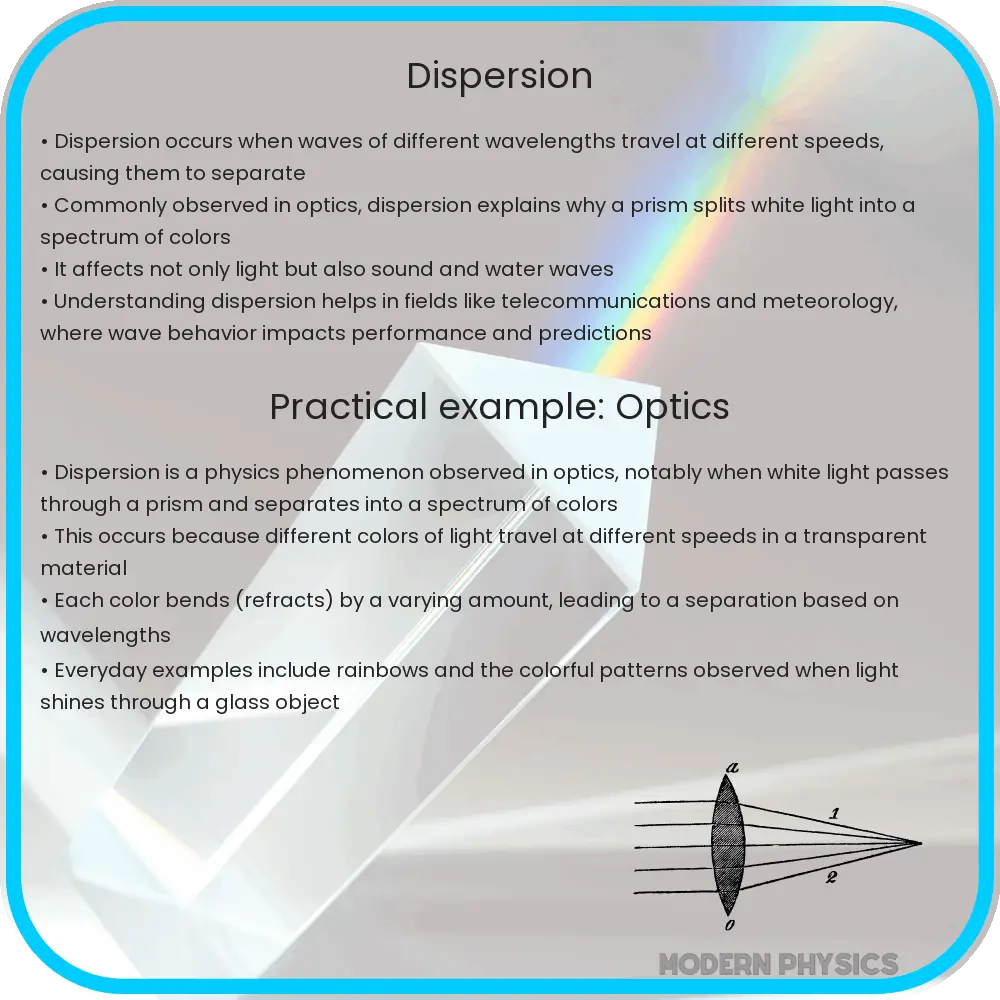Explore the fascinating world of dispersion in optics, uncovering how wave theory and refraction shape light’s behavior and its technological impact.

Understanding Dispersion in Optics: A Wave Theory Perspective
Dispersion is a fundamental concept in optics, crucial for understanding how light interacts with different mediums. It refers to the phenomenon where light separates into its constituent colors due to varying refraction speeds. This article explores the essence of dispersion through the lens of wave theory, refraction, and spectra analysis.
Wave Theory of Light
Wave theory, initially proposed by Christian Huygens in the 17th century, posits that light behaves as a wave. This theory was further bolstered by the work of Thomas Young and Augustin-Jean Fresnel. In wave theory, light waves, comprising electric and magnetic fields, oscillate perpendicular to the direction of wave propagation. This model provides a framework for understanding various optical phenomena, including dispersion.
Refraction and Light’s Speed
Refraction is the bending of light as it passes from one medium to another, caused by a change in light’s speed. According to Snell’s law, the ratio of the sine of the angles of incidence and refraction is constant and depends on the refractive indices of the two mediums. The refractive index of a medium is a measure of how much it reduces the speed of light, defined as \( n = \frac{c}{v} \), where \( c \) is the speed of light in vacuum and \( v \) is the speed of light in the medium.
Dispersion and Spectra
Dispersion occurs because the refractive index of a medium varies with the frequency (or wavelength) of light. This means different colors of light, each with its own wavelength, bend at slightly different angles when passing through a medium. The classic example of dispersion is a prism breaking white light into its component colors, forming a spectrum. The spectrum ranges from red (long wavelength) to violet (short wavelength), demonstrating the varying degrees of refraction experienced by different wavelengths.
Understanding the spectrum is crucial in applications like spectroscopy, where analyzing the spectrum of light emitted or absorbed by substances provides insights into their chemical composition. Spectroscopy relies on the principle that each element absorbs and emits light at specific wavelengths, creating a unique spectral fingerprint.
The significance of dispersion extends beyond the visible spectrum, influencing the behavior of other electromagnetic waves, such as radio and X-rays. This broad impact makes the study of dispersion vital in fields ranging from telecommunications to medical imaging.
In the next section, we will delve deeper into the applications and implications of dispersion in optics, highlighting its role in modern technology and scientific research.
Applications and Implications of Dispersion in Modern Technology
Dispersion plays a pivotal role in a myriad of modern technological and scientific applications. One of the most prominent examples is in fiber optics, where dispersion can affect the transmission of light signals over long distances. Here, understanding and managing dispersion is essential for efficient data transmission, impacting internet speeds and communication quality.
In the realm of photography and cinematography, lenses are designed considering dispersion to prevent chromatic aberration, where colors are incorrectly refracted, leading to color fringes in images. Advanced lens designs often include special low-dispersion glass to minimize this effect, enhancing image clarity and color accuracy.
Challenges and Solutions in Dispersion Management
While dispersion offers beneficial applications, it also presents challenges, particularly in precision optics and telecommunications. For instance, in high-speed data transmission through optical fibers, dispersion can cause pulse broadening, leading to signal loss and decreased transmission efficiency. To combat this, engineers use dispersion compensation techniques, such as dispersion-compensating fibers and electronic signal processing, to correct distortions and optimize signal integrity.
In astronomical observations, atmospheric dispersion can affect the accuracy of telescopic images. Adaptive optics technology counters this by adjusting the telescope’s optics in real-time, correcting distortions caused by atmospheric turbulence and dispersion.
Conclusion: The Broad Spectrum of Dispersion’s Influence
In conclusion, dispersion in optics, rooted in wave theory and the phenomenon of refraction, is a cornerstone concept in understanding how light interacts with matter. Its implications stretch across various fields, from the vivid display of a rainbow to the intricate workings of fiber optic communication. Dispersion not only reveals the rich tapestry of light’s interaction with the world but also poses unique challenges that drive innovation in technology and science. As we continue to explore and harness the properties of light, the study of dispersion remains integral, offering endless potential for discovery and advancement in the optical sciences.
Whether it’s enhancing the quality of images captured in photography or ensuring the clarity of communications over vast distances, dispersion is an unseen yet ever-present force shaping the way we perceive and interact with the world around us. Its study not only deepens our understanding of the fundamental nature of light but also inspires continued progress in the technologies that light up our lives.
